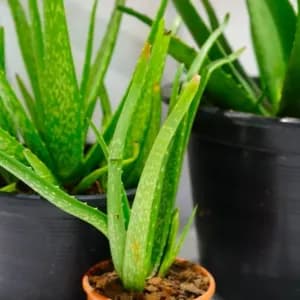Spider lily blooms in the summer and fall, rising up on tall, slender stalks from the plant's basal rosette of leaves. Apart from their stunning appearance, spider lilies are known for their captivating fragrance that often attracts various pollinators such as butterflies and moths.
Spider lily is a relatively easy-to-grow plant that enjoys full to partial sun exposure and moist, well-draining soil. It can be planted outdoors or in containers, making it versatile and adaptable to various growing conditions.
Overview
Spider lilies, with their delicate yet captivating blossoms, are a favorite among garden enthusiasts and flower lovers. Also known as Hymenocallis, these elegant plants add a touch of exotic beauty to any garden or indoor space. Spider lilies are renowned for their unique star-shaped, white, or cream-colored flowers, often adorned with long, spidery petals that give them their intriguing name.
If you're considering adding spider lilies to your garden or already have them and want to ensure they thrive, this comprehensive guide is here to help. New York Garden will delve into how to grow and care for the Spider Lily, exploring their origins, ideal growing conditions, propagation methods, and tips for keeping them healthy and vibrant throughout their growth cycle.
|
Soil Type |
Well-drained |
|
Bloom Time |
Summer, fall |
|
Common Name |
Spider lily, hurricane lily, cluster amaryllis, naked lily, surprise lily |
|
Flower Color |
Red, orange, pink, white, yellow |
|
Plant Type |
Perennial, bulb |
|
Botanical Name |
Lycoris spp. |
|
Sun Exposure |
Full, partial |
|
Native Area |
Asia |
|
Family |
Amaryllidaceae |
|
Soil pH |
Acidic, neutral, alkaline |
|
Hardiness Zones |
6–10 (USDA) |
|
Mature Size |
1–2 ft. tall, 1–1.5 ft. wide |
Types of Spider Lily
Spider lilies are a group of flowering plants that belong to the family Amaryllidaceae [1]. They are known for their showy, spider-like flowers that come in various colors and shapes. There are many types of spider lilies, but some of the most common ones are:
-
Red spider lily (Lycoris radiata): With long, curled filaments that resemble spider legs, this variety features vivid red blooms. It blooms in the late summer or early autumn and is indigenous to China, Japan, and Korea. Because it frequently blooms after a storm or a drought, it is also known as the Orange Day-Lily or the Lily Magnolia.
-
White spider lily (Hymenocallis littoralis): The long, thin filaments of this kind are surrounded by white blooms with a green core. It blooms in the spring or summer and is indigenous to tropical and subtropical parts of the Americas. Because it grows close to the coast or in marshes, it is also known as the Peruvian daffodil or the beach spider lily.
-
Yellow spider lily (Lycoris aurea): Compared to the red spider lily, they have yellow blossoms with shorter, thicker filaments. It blooms in the late summer or early fall and is indigenous to China and Southeast Asia. Due of its color and timing, it is also known as the golden spider lily or the golden storm flower.
-
Pink spider lily (Crinum asiaticum): This type has pink flowers with a white center and long, thin stamens. It is native to tropical and subtropical regions of Asia and Australia, and blooms in summer or autumn. It is also called the poison bulb or the giant crinum lily because it has a large, toxic bulb that can cause skin irritation or nausea if ingested.
How to Grow Spider Lily
Spider lilies are exotic and beautiful flowers that can add a touch of color and fragrance to your garden. They are easy to grow and require minimal care, as long as you provide them with the right conditions. Here are some tips on how to grow spider lilies successfully.
Choosing the right location
To give spider lilies the best possible environment to thrive, choose a spot in your garden where there is plenty of sunlight, but not too much direct heat. These plants enjoy warmth, but the excessive heat can damage the flower petals or leaves. Additionally, spider lilies require well-draining soil to prevent water-logging, which could rot the bulbs.
Preparing the soil
To ensure that the spider lily bulb grows well, it is essential to prepare the soil correctly. Before planting, loosen the soil to about six inches deep, and remove any old roots or organic debris. Break up clumps of soil and add organic matter, such as compost or aged manure, to enhance its fertility.
Planting the spider lily bulbs
Spider lily bulbs should be planted in the fall or early spring. In areas with frost, they should be planted in the spring to avoid damage from cold weather. The bulbs should be placed about six inches deep into the soil, sparingly spaced around the flower bed or in a pot.
After planting, water the bulbs well, and add some 4-4-4 nitrogen, phosphorus, and potassium fertilizer. Water the spider lilies regularly and wait for them to emerge. With just a little bit of care, you'll have a beautiful spider lily plant to enjoy.
Watering
Spider lilies require regular watering, especially in the growing season. Water them deeply to a depth of approximately six inches, so that the roots receive enough water. Also, ensure that the soil is well-draining to prevent water from pooling around the bulbs. Overwatering can lead to the rotting of bulbs and leaves, while underwatering will affect their bloom rates.
It's also important to water spider lilies regularly during the hot season to keep the soil moist. However, they don't require as much water in the dormant season [2], so reduce the quantity of water you give them at that time.
Fertilizing
Spider lilies require a small amount of fertilizer during their growth stage. Fertilizers high in phosphorus are best for spider lilies as they help to promote bloom rates. Apply a slow-release fertilizer to the plant bulbs in the amount and frequency recommended by the manufacturer.
Avoid over-fertilizing spider lilies, as this can lead to imbalanced growth or reduced blooming rates. Do not fertilize spider lilies during their dormant season, as it may damage the bulbs.
Propagating Spider Lilies
Propagating spider lilies is a fun and easy way to add some color and fragrance to your garden. Spider lilies are bulbous plants that produce clusters of red, pink, white or yellow flowers that resemble spiders. They bloom in late summer or early fall and attract hummingbirds and butterflies.
To propagate spider lilies, you can either divide the bulbs or grow them from seeds. Dividing the bulbs is faster and more reliable, but growing from seeds can give you more variety. Here are the steps for both methods:
- Dividing the bulbs: Dig up the clumps of spider lilies after they finish flowering or in early spring before they sprout. Gently separate the bulbs and replant them in well-drained soil, about 3 inches deep and 6 inches apart. Water them well and mulch them to keep the soil moist and cool. You can expect new flowers in the next season.
- Growing from seeds: Collect the seeds from the pods that form after the flowers fade. Store them in a cool and dry place until spring. Sow them in pots filled with moist potting mix, about 1/4 inch deep. Place them in a sunny spot and keep the soil moist but not soggy. Transplant them to the garden when they have at least two sets of leaves, following the same spacing and depth as for the bulbs. You may have to wait a few years before they bloom.
Potting and Repotting Spider Lilies
Spider lilies are beautiful plants that can brighten up any garden or home. They are easy to grow and care for, but they do need some attention when it comes to potting and repotting. Here are some tips on how to do it right.
- Potting spider lilies: Spider lilies can be grown from bulbs or seeds. If you have bulbs, you can plant them in pots filled with well-draining soil mix. Make sure the bulbs are not buried too deep, just enough to cover them with soil. Leave some space between the bulbs for them to grow. Water them well and place them in a sunny spot. If you have seeds, you can sow them in pots filled with moist seed-starting mix. Cover them lightly with soil and keep them in a warm and bright place. Water them regularly and wait for them to germinate.
- Repotting spider lilies: Spider lilies like to be root-bound, so you don't need to repot them too often. However, if you notice that the roots are coming out of the drainage holes or the soil is too compacted, it's time to repot. Choose a pot that is slightly larger than the previous one and has good drainage. Gently remove the plant from the old pot and shake off any excess soil. Trim any damaged or rotten roots and place the plant in the new pot. Fill the gaps with fresh soil mix and water well. You can also divide the plant if it is too crowded or you want to propagate it. Simply cut the root ball into sections, making sure each one has some bulbs and roots attached. Pot each section separately and water well.
How to Get Spider Lilies to Bloom?
Spider lilies are beautiful flowers that can add a touch of color and elegance to your garden. But how do you get them to bloom? Here are some tips to help you enjoy these lovely plants.
- Spider lilies are bulbs that need a period of dormancy before they can flower. This means they should be planted in late summer or early fall, when the soil is still warm but not too hot. They will grow roots and leaves until the winter, then go dormant until the spring.
- Spider lilies like well-drained soil that is rich in organic matter. You can add compost or manure to improve the soil quality and fertility. They also prefer slightly acidic soil, so you can use a pH tester to check the acidity level and adjust it with lime or sulfur if needed.
- Spider lilies need full sun or partial shade to thrive. They can tolerate some drought, but they will bloom better if you water them regularly during the growing season. You can also apply a balanced fertilizer once or twice a year, in the spring and/or the fall, to boost their growth and flowering.
- Spider lilies are not very prone to pests or diseases, but they can be affected by slugs, snails, aphids, or spider mites. You can use organic or chemical methods to control these problems, such as hand-picking, traps, sprays, or dusts. You should also remove any dead or diseased leaves and flowers to prevent fungal infections.
- Spider lilies will bloom in late summer or early fall, depending on the variety and the climate. They will produce clusters of red, pink, white, or yellow flowers that look like spiders on long stems. The flowers are fragrant and attractive to bees and butterflies. You can cut some of them for bouquets, but leave some on the plant to allow them to form seeds for next year.
Common Problems With Spider Lilies
Spider lilies are beautiful flowers that can add a touch of color and elegance to your garden. However, they are not without their challenges. Here are some common problems with spider lilies and how to deal with them.
- Spider mites: These tiny pests can suck the sap from the leaves and stems of your spider lilies, causing them to turn yellow and drop off. To prevent spider mites, keep your plants well-watered and avoid dry and dusty conditions. You can also spray your plants with a mixture of water and a few drops of dish soap or neem oil to deter the mites.
- Bulb rot: This fungal disease can cause the bulbs of your spider lilies to decay and produce a foul smell. Bulb rot can be caused by overwatering, poor drainage, or planting the bulbs too deep. To prevent bulb rot, plant your spider lilies in well-drained soil and avoid watering them too much. You can also apply a layer of mulch around the base of the plants to keep the soil moist but not soggy.
- Leaf scorch [3]: This condition can cause the edges of the leaves of your spider lilies to turn brown and crispy. Leaf scorch can be caused by exposure to direct sunlight, high temperatures, or strong winds. To prevent leaf scorch, plant your spider lilies in a shady or partially shady spot and protect them from extreme weather conditions. You can also water your plants regularly and mist them with a spray bottle to keep them cool and hydrated.
FAQs
Spider lilies are beautiful and easy-to-grow plants that can add a touch of tropical flair to your garden or indoor space. Here are some frequently asked questions and answers about how to grow and care for these exotic flowers.
What are spider lilies and where do they come from?
Spider lilies are bulbous plants that belong to the Amaryllidaceae family. They have long, strap-like leaves and clusters of spidery flowers that come in various colors, such as white, pink, red, yellow, or orange. Spider lilies are native to tropical and subtropical regions of Asia, Africa, and the Americas.
How do I plant spider lilies?
Spider lilies can be grown in pots or in the ground. They prefer well-drained soil that is rich in organic matter. You can plant them in spring or fall, depending on your climate. Plant the bulbs about 3 inches deep and 6 inches apart, with the pointed end facing up. Water them well after planting and keep the soil moist but not soggy.
How do I care for spider lilies?
Spider lilies are low-maintenance plants that do not require much attention. They like full sun to partial shade and moderate watering. You can fertilize them once or twice a year with a balanced fertilizer. Spider lilies are drought-tolerant and can survive dry spells, but they will bloom better if you water them regularly during the growing season. Spider lilies are also resistant to most pests and diseases, but you should watch out for aphids, spider mites, and bulb rot.
The New York Garden works under restricted procurement guidelines and relies on peer-reviewed studies and studies conducted by academic organizations. Tertiary references should be avoided. For more information on how we ensure our material is correct and up to date, please visit our editorial policy.
- Family Amaryllidaceae - National Library of Medicine
- Dormant season - University of California
- Leaf scorch - Department of Labor















